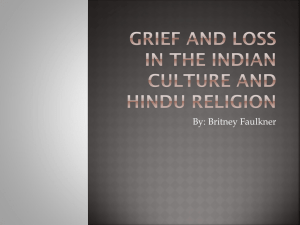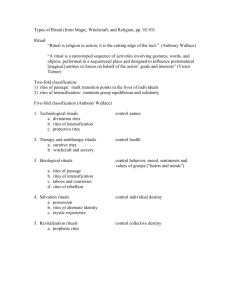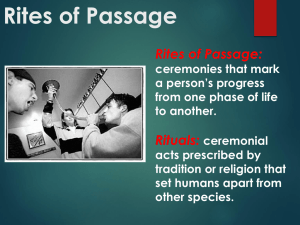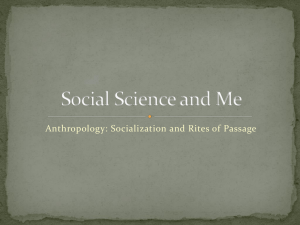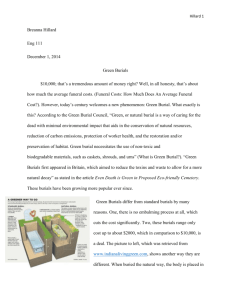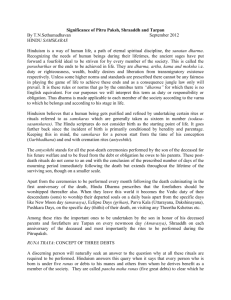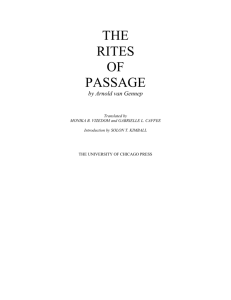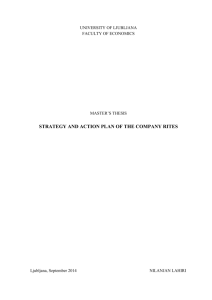Cross Cultural Differences in Burial Practices
advertisement
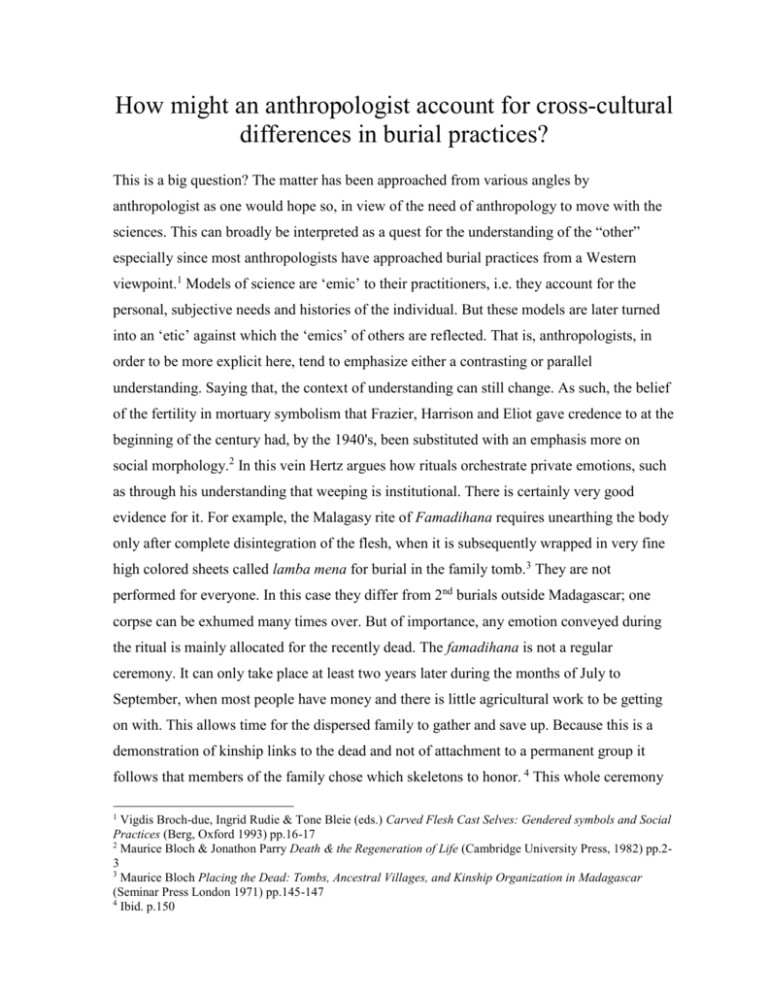
How might an anthropologist account for cross-cultural differences in burial practices? This is a big question? The matter has been approached from various angles by anthropologist as one would hope so, in view of the need of anthropology to move with the sciences. This can broadly be interpreted as a quest for the understanding of the “other” especially since most anthropologists have approached burial practices from a Western viewpoint.1 Models of science are ‘emic’ to their practitioners, i.e. they account for the personal, subjective needs and histories of the individual. But these models are later turned into an ‘etic’ against which the ‘emics’ of others are reflected. That is, anthropologists, in order to be more explicit here, tend to emphasize either a contrasting or parallel understanding. Saying that, the context of understanding can still change. As such, the belief of the fertility in mortuary symbolism that Frazier, Harrison and Eliot gave credence to at the beginning of the century had, by the 1940's, been substituted with an emphasis more on social morphology.2 In this vein Hertz argues how rituals orchestrate private emotions, such as through his understanding that weeping is institutional. There is certainly very good evidence for it. For example, the Malagasy rite of Famadihana requires unearthing the body only after complete disintegration of the flesh, when it is subsequently wrapped in very fine high colored sheets called lamba mena for burial in the family tomb.3 They are not performed for everyone. In this case they differ from 2nd burials outside Madagascar; one corpse can be exhumed many times over. But of importance, any emotion conveyed during the ritual is mainly allocated for the recently dead. The famadihana is not a regular ceremony. It can only take place at least two years later during the months of July to September, when most people have money and there is little agricultural work to be getting on with. This allows time for the dispersed family to gather and save up. Because this is a demonstration of kinship links to the dead and not of attachment to a permanent group it follows that members of the family chose which skeletons to honor. 4 This whole ceremony 1 Vigdis Broch-due, Ingrid Rudie & Tone Bleie (eds.) Carved Flesh Cast Selves: Gendered symbols and Social Practices (Berg, Oxford 1993) pp.16-17 2 Maurice Bloch & Jonathon Parry Death & the Regeneration of Life (Cambridge University Press, 1982) pp.23 3 Maurice Bloch Placing the Dead: Tombs, Ancestral Villages, and Kinship Organization in Madagascar (Seminar Press London 1971) pp.145-147 4 Ibid. p.150 is for the deceased that have not been previously touched, and then it is the duty of those most closely linked, like the parents, children and sisters.5 Women are here considered in this capacity. Once the graves are opened and the bodies removed and wrapped in lamba mena, the ensuing dance with the enshrouded bodies on their shoulders may appear as sacrilege. It is of no small wonder that this is a time of great anxiety and fear, when the younger women are visibly forced to touch the wrapped dead. It is the women that keep the kinship links strong. Fear subsides and is generally replaced with high spirits. The crowd divides and skeletons are laid on the lap of the women. It is clear here, amongst many other examples, that emotion, whether controlled or sporadic, has been institutionalized into a social system of rites and rituals. The corpse is a social manifestation, the funerary rites of which seek to reestablish the destabilization incurred by the death of an individual and subsequently, the loss of that individual from the collectivity.6 The social unrest must be alleviated, as are the former roles of the deceased in society. Huntington and Metcalf flag up Hertz and his treatment of the passage of the soul but ignore the emotional content of funerary rites that the latter broadly refers to. They also treat the links between death and fertility with much less importance, giving precedence rather to the considerable prominence of the life values of fertility and sexuality in funerary practices; a reassertion of life in the face of death. The example here is of the Bara of Madagascar in which sexual themes dominate all funeral singing.7 As with the Berawan of central Borneo, funerals are opportunities to broach sexual liaisons whilst expressing a stored vitality. The symbolic dances of vitality; the stampeding of the cattle hooves ploughing up the fields and obviously symbolic of fertility; the customary mass killing of cattle at funerals signifying its legendary status as a drinker of all life. Even incestuous behavior is tolerable but only during these ceremonies. The symbolism here is one of chaos or instability, like the killing of divine kings as an act to regenerate the fertility of the community or land. Frazer, in his clinical tone, dispatches a range of kings through the action of his peers when, for example, the king becomes frail.8 One may also refer to his examples of regicide dictated through customary rites that assign 5 Ibid. pp.156-157 Maurice Bloch & Jonathon Parry op. cit. pp.4-6 7 Richard Huntington and Peter Metcalf Celebrations of Death – The Anthropology of Mortuary Ritual (Cambridge University Press, London 1979) pp.110-114 8 Sir James Frazer The Golden Bough pp.265-266 6 fixed terms.9 The mythological bearing of many of these principle figures could probably take their root in primitive religious beliefs that relate to vegetation or cosmic cycles, an indication of the seasonal nature of ritualistic cycles and the authoritative administering of rites. John Barleycorn would be a good example here. Frazer shows that ritual regicide was a general tradition of the ancient world. In Southern India the reign ended with the complete revolution of the planet Jupiter whilst in Greece the king had an octennial cycle. 10 The phenomenon resonates along the lines of current Hindu belief systems, in which it is believed that the regeneration of life is the cause of death, and sexual relations, especially for the male, are seen as entailing a depletion of life essence,11 i.e. the king must remain pure through the storing of vitality. To bear a child is a mythical raison d’être for his succession or death. Social hierarchies and gender orders are explicit in much of the burial rites around the world. Within the Bara ceremonials for instance, the hired dancers represent points of instability.12 They embody low status and are seen as outside the social and moral order. Normality must always ensue though. There is another interesting parallel here, for the Hindu who cremate the corpse soon after death, the body is not a feature of their rites, rather it is just a container.13 This is similar amongst the Balinese whose rites of burials are factors of status and wealth. Simple burials of earth occur frequently but they resemble Hindu elements in cremating the body as soon as possible. They differ in that the Hindu is not concerned with the body in rite, but rather see it as just a container. The Balinese on the other hand resemble Indonesian demands like the Ma’anyan who say that cremation happens only after corruption of the corpse. The allimportant factor is this period of liminality between death and rebirth/restoration of fertility. Likewise the Iban of Borneo make offerings to the dead in order to secure safe and hospitable entry for their new member. The actual corpse rapidly diminishes in importance and remembrance. But 2nd burials are a major factor of Indonesian rites and though the flesh may be regarded as an element of fertility that requires corruption before the soul can finally move on into the Land of the Dead, Hertz warned against over-applying a generality to Indonesian rites. He referred to economics being a governing factor in decision-making 9 Ibid. pp283-289 Joseph Campbell The Hero with a Thousand Faces (Fontana Press, London 1993) pp.93-94 11 Maurice Bloch & Jonathon Parry op. cit. p.8 12 Richard Huntington and Peter Metcalf op. cit. p.115 13 Ibid. pp.85-89 10 processes.14 For instance, the Ma’anyan dead are dealt with collectively as a second burial; they are taken from the graveyard and stacked for burning. The ashes are collected and stored in a large wooden container in the graveyard. Food may also be taken to the graveyards for as long as 3 years. Here, a close relative is locked up for a period, usually the mother. But importantly the corpse must go through complete bacterial deterioration of the flesh. Practicality and economic rationale have an indubitable role to play then. Secularization in the west, coming off the back of the new scientific rationale with an increasing elitism of a developing bourgeoisie class, aided the living in accepting death if only for serving to raise the social standing of one’s heirs and associates.15 But even before this the implicit character of the belief in non-death and the new eucharistic cult emerging in successive centuries had already given acceptance to succeeding waves of epidermal deaths and famines and its high urban mortality. Urban living, despite demographic surveys showing consistent rates of mortality, offered practical economic and social benefits, hence the continual influx of migrants. Death had brought much benefit to a number of townspeople; the grand funerals in particular required a number of clergy, victuallers, and a host of specialist craftsmen. Post-reformation society did little more to detract people from the realism of death. In fact, it was more concerned with comforting the living than helping the dead, since it had rejected the efficacy of prayers and the concept of purgatory. The practical and social pressure to seek burial in monumental surroundings went hand in hand with urban development. Smaller towns were in a position to protect their buried from urban sprawl, but the problem of waste disposal and also close grave digging practices were inherent on larger British towns. This was guaranteed by expensive costs. Roman ideals of ritual and actual pollution were lost to the practical exigencies of urbanization. Hence the construction of leper homes and hospitals near or within urban environments was a distinguishable practice for both urban and rural burials. This essay ends then, highlighting the need to take into consideration gender roles, status, the wealth of kinsmen, the comfort of the living, the afterlife of the soul and the notions of fertility in belief systems. But there are many other areas to consider for instance 14 Ibid. pp.82-83 Steven Bassett (ed.) Death in Towns: Urban Responses to the dying and the dead 100-1600 (Leceister University Press, London 1995) pp.2-5 15 the mode of dying, power relations and the actual place of death. Hertz took much data from Borneo, and in reference to the Berawan discovered the existence of abbreviated rites. 16 Some communities dispense of the songs, yet the soul still undergoes a protracted metamorphosis and unmarked entry into the Land of the Dead. That some communities favor the abridged rites over full rites Hertz considered the result of the effects of cultural impoverishment as the process to inducing modern compromises. Though Metcalf and Huntington assert their disagreement it still maybe indicates a possible modern influence over tradition, especially from outsiders and the effect of local economy. But what remains is this, that the corpse and the soul will always share a same fate. 1. Vigdis Broch-due, Ingrid Rudie & Tone Bleie (eds.) Carved Flesh Cast Selves: Gendered symbols and Social Practices Berg, Oxford 1993 2. Maurice Bloch & Jonathon Parry Death & the Regeneration of Life Cambridge University Press, 1982 3. Maurice Bloch Placing the Dead: Tombs, Ancestral Villages, and Kinship Organization in Madagascar Seminar Press London 1971 4. Richard Huntington and Peter Metcalf Celebrations of Death – The Anthropology of Mortuary Ritual Cambridge University Press, London 1979 5. Steven Bassett (ed.) Death in Towns: Urban Responses to the dying and the dead 1001600 Leceister University Press, London 1995 6. Sir James Frazer The Golden Bough: A History of Myth and Religion Chancellor Press, London 1994 7. Joseph Campbell The Hero with a Thousand Faces Fontana Press London 1993 16 Richard Huntington and Peter Metcalf op. cit. pp.79-81
